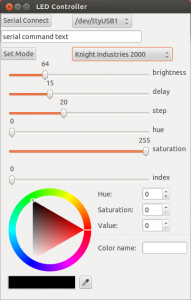I had a little trouble finding references to how to setup multiple strips with FastSPI2, so I thought I’d post this.
You just use an offset value like in this example:
LEDS.addLeds<WS2801, 7, 9, RGB>(leds, 43); //<---Strip1 - WS2801 - 43 LEDs LEDS.addLeds<WS2801, 11, 13, RGB>(leds, 43, 12); //<---Strip2 - WS2801 - 12 LEDs LEDS.addLeds<WS2811, 5, GRB>(leds, 55, 16); //<---Strip3 - WS2811 - 16 LEDs
In the additional strips the first integer passed becomes the offset value and the second is the number of LEDs in the strip.
LEDS.addLeds<STRIP, CLK_PIN, DATA_PIN, RGB_ORDER>(ARRAY, OFFSET, LED_COUNT);
